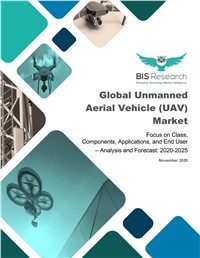Key Questions Answered in this Report:
- What are the trends in the global unmanned aerial vehicle (UAV) market across different regions?
- What are the major driving forces for increasing the global UAV market demand during the forecast period 2020-2025?
- What major opportunities do UAV companies foresee in the next five years?
- Which application (inspection and monitoring, surveying and mapping, search and rescue, remote sensing, product delivery, border management, photography and film production and others) dominated the global UAV market in 2019, and what is the expected scenario by 2025?
- What are the endu-user that dominated different industries in 2019, and what is the estimated revenue during the period 2020-2025?
- What was the revenue generated through different components in 2019, and what are the estimates for 2020-2025?
- What was the aggregate revenue generated by the global UAV market segmented by region (North America, Europe, Asia-Pacific, and Rest-of-the-World) in 2019, and what are the estimates for 2020-2025?
- Which are the key players in the global UAV market, and what are the new strategies being adopted to make a mark in the industry?
- What is the competitive strength of the leading players in the global UAV market?
Global Unmanned Aerial Vehicle (UAV) Market Forecast, 2020-2025
The unmanned aerial vehicles (UAV) industry analysis by BIS Research projects the market to grow at a significant CAGR of 13.27% based on value during the forecast period from 2020 to 2025. The North America region dominated the global UAV market with a share of 51% by value in 2019. Its total market size was valued at $11.66 billion in 2019 and is projected to reach $ 21.91 billion by 2025, registering the highest CAGR value during the forecast period of 2020-2025. This is due to the presence of many drone manufacturing companies in the region. Additionally, countries such as China, Japan, South Korea, Australia, and Singapore are adopting UAVs rapidly, making Asia-Pacific the second-largest market for UAVs. The global UAV market in APAC was valued at $5.45 billion in 2019 and is expected to grow at a CAGR of 15.64% during the forecast period 2020-2025.
The global UAV market has gained widespread importance due to the growing usage of drones for inspection, surveying, transport and logistics, and agricultural spraying, among others. Some of the drones provide surveillance and monitoring services to military, homeland security, and law enforcement applications, which are fueling the growth of the market.
Scope of the Global Unmanned Aerial Vehicles Market
The Unmanned Aerial Vehicles (UAV) Market research provides detailed market information for segmentation such as class, application, component, and end user. The purpose of this market analysis is to examine the UAV market outlook in terms of factors driving the market, trends, technological developments, key strategies and developments, among others.
The report further takes into consideration the market dynamics and the competitive landscape, along with the detailed financial and product contribution of the key players operating in the market.
Global Unmanned Aerial Vehicle (UAV) Market Segmentation
While highlighting the key driving and restraining forces for this market, the report also provides a detailed study of the different industries, including consumer, commercial, and government & defense. The report also analyzes different applications that include inspection and monitoring, surveying, and mapping, search and rescue, remote sensing, product delivery, border management, photography and film production, and others.
The UAV market has been segregated by region under four major regions, namely North America, Europe, Asia-Pacific, and Rest-of-the-World. Country-wise analysis data for each of these regions has also been provided in the report.
Key Companies in the Global UAV Industry
The key market players in the global UAV market include Aerovironment Inc., Airbus S.A.S, Ehang, DJI, Lockheed Martin, Boeing, FLIR System, Northrop Grumman, BAE Systems, Thales Group, Israel Aerospace Industries Limited, General Atomics, General Dynamics, among others.



